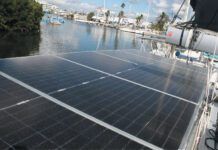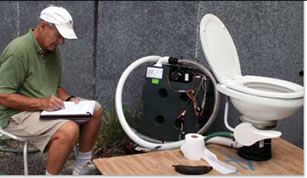
In the February and March 2011 issues, Practical Sailor reviewed 14 popular electric-flush marine toilets. All had various types of 12-volt or 24-volt water pumps or macerator pumps to move waste out of the toilet bowl. In our ongoing effort to evaluate on-board sanitation equipment, we had an opportunity to test some toilets that rely on a vacuum (negative air pressure) in the lines for flushing.
Similar to the types of toilets found in airline lavatories, these toilets are touted for their ability to flush with very little water. In order to reduce water use, some newer homes are employing pressure-assisted toilets that operate on a similar principle.
Most makers also claim the design helps eliminate odors and keeps the system cleaner and bacteria-free since they use onboard fresh water, instead of raw sea water, for flushing. Most vacuum systems use only about 2 pints of water per flush, so they conserve the fresh water supply and increase holding-tank capacity.
What We Tested
PS worked with two electric vacuum-flush units from Dometic Corp. and a manual unit from Blakes Lavac Taylors. The Dometic Group also markets products under the Sealand brand name.
Dometic offers a wide range of marine sanitation systems and toilets in addition to the six different series of its VacuFlush line of vacuum toilets. Its 5000 series of compact VacuFlush toilets is geared for medium-size sailboats. The No. 5006 is the shortest in the series. We tested the taller No. 5048 and No. 5148.
For sailors looking to replace older, compact manual heads, the 140 series will likely be a better fit, and for owners of larger yachts who want a residential-style toilet, the premium-grade 4000-series models are worth a look.
The Blakes Lavac toilet is a manual toilet system that is made in the United Kingdom. It is significantly different from the VacuFlush toilets in that the powerful suction is generated only during flushing, whereas VacuFlush lines are airtight and kept at a constant negative pressure.
The Lavac was first introduced in 1963 and has served on many small sailboats around the world. It is imported into the U.S. by St. Brendan’s Isle Co. in Green Cove Springs, Fla. As we reported in our last comprehensive test of manual toilets in September 2000, it is small, relatively inexpensive, easy to use, and easy to maintain.
How We Tested
As in our previous toilet evaluations this year, this was a controlled bench test. We compared size, weight, price, style, features, and functions. We reviewed installation instructions and documentation, parts inventory, construction and ruggedness of materials, ease of installation, installation options, added features, and customer service.
To test the electric toilets, we hooked up the Dometic vacuum pumps to a fully charged, 12-volt battery and installed the proper hoses for water intake and waste discharge. The installers evaluated the ease of electrical and plumbing hookup, commented on possible ease of maintenance, and compared functions. Testers also measured amp draw, sound level, and ease of use. For filling, flushing, and rinsing the Dometic units, which call for a pressurized water supply, testers hooked up a standard three-quarter-inch garden hose at low pressure to draw water into the bowls. The Blakes Lavac toilet is manually operated, so it didn’t need 12-volt power, nor did it need a pressurized water intake.
To compare flushing, we mixed equal batches of “faux poo,” consisting of a rotten banana and 4 feet of West Marine Pure Oceans single-ply, quick-dissolve tissue paper, and evaluated the speed and efficiency of the waste discharge.
It is worth noting that Dometic included a bright yellow “Technical Alert” sheet that specifically called for quick-dissolve toilet tissue used in these systems. One brand in particular, Charmin Ultra-Soft toilet tissue—was cited as a known cause of clogged vacuum generators and tanks. The company recommended Sealand Ultra Two-ply TP, although we found others that dissolved just as well or better in our recent toilet paper test (See PS, June 2011).
Dometic (Sealand) No. 5048
This is a standard, mid-size toilet with a semi-oval ceramic bowl sitting on an 8½-inch diameter plastic base. The base has a white plastic cowling that wraps around, snaps in place, and is held by one screw. The cover is purely cosmetic, adding smooth curves to the toilet’s base. It has a heavy-duty wood lid and cover. For our first test, the waste outlet of the 5048 was led to the J-series VG4 vacuum generator (described below).
On the side of the toilet is a control handle and valve that you control with your foot. (Dometic’s electric units have a bulkhead-mounted push-button as an option.) Various sensors and panels to check for vacuum leaks or monitor holding-tank level are optional.
Lifting up the foot pedal allows water to enter the bowl. Pushing down opens the water inlet valve as well as a 3-inch diameter plastic ball valve at the bottom of the bowl. This opens up the suction line, allowing the vacuum generator to suck out water and waste from the bowl and pump it into the holding tank. The water and waste are pulled through a small 1-inch opening under the ball valve. This passage is deliberately sized smaller than the other plumbing to make it easy to clear any foreign material that might clog the system. The vacuum in the line automatically re-charges after each flush. In our installation, with 6 feet of hose between the vacuum generator and the toilet, this took 30-40 seconds.
The operation of the ball valve at the bottom of the bowl depends on the tight fit of two, round, 7-inch rubber gaskets. These seals are Teflon coated and should last for years, but may need to be checked and cleaned periodically in order to keep an airtight seal. Cleaning is a simple matter of reaching down from the bowl with a sponge or brush, just as you would clean a home toilet. The use of clean fresh water will minimize the build-up of salts, minerals, and foreign material that might inhibit this seal.
Dometic offers several options for generating vacuum pressure in the lines, ranging from the compact S-type vacuum generator to the bronze-body M Series for multiple toilets. Our test toilet came with the new J-series VG4 vacuum generator and tank, which Dometic says employs its new “whisper quiet” technology. This is a white plastic box about the size of a toolbox—6 inches high, 7 inches wide, and 19 inches long—with flanges for securing to a floor or bulkhead and 1½-inch hose fittings for waste input and output.
On the top of the vacuum generator is a 12-volt, 6-amp motor to operate the vacuum pump. The motor is activated by a pressure-sensitive internal vacuum switch and is protected by an internal thermal cutoff switch. Early versions of the vacuum switch, which should not be adjusted by the user, had some problems, but according to Dometic, there have been very few switch problems since 2008.
To wire the generator, you simply connect the positive and negative leads to 12-volt power, with a 10-amp fuse or breaker to protect the circuit against over-current.
This J Series 6-amp motor is a good size for its dual function of sucking in waste from the toilet and pushing it out to a holding tank. Specifications call for locating the vacuum generator within 50 feet horizontally and 6 feet vertically from the toilet. The pump is supposed to push the waste up to 6 feet vertically overboard or to a holding tank. During our test, the pump managed to pulse waste out of the vacuum generator at the 6-foot level but did not clear the hose completely. Installers should aim for short hose runs with the least amount of lift (the vertical distance a pump has move waste), particularly after the vacuum generator. The hose between the vacuum generator and the toilet typically retains little water because it is under vacuum.
Four bi-cuspid “duckbill” valves prevent any effluent from getting back into the toilet. When testers ran the vacuum generator outlet hose horizontally, all the water and waste was pumped out. The operation is fairly quiet except for one initial, quick “pop” in the bowl. The pump motor noise is a tolerable hum that lasts less than a minute (30 to 40 seconds in our installation) as the vacuum recharges.
During testing, we experienced one clog, as one of our test bananas blocked the inlet valve at the base of the toilet. (According to Dometic, our test bananas are denser than human waste.) We were able to dislodge it without too much trouble by reaching into the bowl with a plastic knife. To help clear clogs, four screws at the top of the vacuum generator allow you to easily remove the pump for access to the chamber below. The entire lid may also be removed for more thorough cleaning.
Bottom line: This unit generated the fastest, most powerful vacuum flush of the three toilets we tested, and the motor was surprisingly quiet—except for the pop, which was loud enough to wake sleeping bunkmates. The J-series vacuum generator permits a wide range of installation options. Since the generator becomes, in essence, a temporary holding tank for waste and paper, owners need to be vigilant about what goes in.
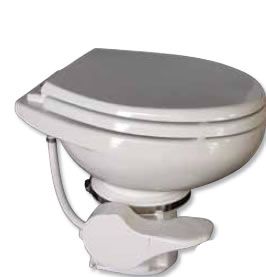
Dometic / Sealand 5148
The bowl, seat, and cover of the No. 5148 we tested were identical to the No. 5048, but the base was smaller and about 1½ inches shorter. The white plastic base is all one piece without the extra cover. Unfortunately, the plastic threads on the half-inch inlet fitting on our test toilet were misaligned or damaged, and we had to find a replacement. The 5148 has a “pedal-lock” feature that holds the foot pedal down and flush ball open during a holding-tank pump-out.
The 5148 came with a SailVac VHT 5200, an integral vacuum generator and holding tank (14 gallons). This system could be used with any of the company’s VacuFlush toilets, and is one of several integral vacuum pump/holding tank options that Sealand offers in sizes ranging from 6 to 14 gallons. The SailVac holding tank is specifically shaped to install vertically in the outboard bulkhead space in a head. It is exactly the same size as Sealand tanks already found on some production boats.
Sealand claims the VHT 5200 provides enough holding tank capacity for two people for four days, and we found this to be an accurate—if not conservative—statement. It comes pre-wired with a 12-volt, 3-amp motor, a vacuum pump, internal vacuum switch, and a tank sensor indicating when the tank is three-quarters full and full. There are also relays for an alarm and auto shutdown.
The tank is made of a green, heavy-duty polyethylene composite material and is 36 inches high, 20 inches wide, 11 inches deep at the top and 5 inches deep at the bottom. The 1½-inch diameter hose connections fit snuggly into three round, flexible, rubberized donut rings, which, in turn, squeeze snugly into the tank.
The threadless design allows the fittings to turn a complete 360 degrees to point in any direction, but the hose fittings and donut must fit smoothly and tightly in order for the tank to maintain the vacuum. One fitting is for the waste inlet from the toilet, and the other is an outlet to another holding tank, offshore pump-out, or dockside pump out.
The top of the tank has a 5/8-inch discharge fitting exiting the air pump to evacuate the foul odors while the air pump creates a vacuum. There is no vent in this system. The vacuum pump is quiet, but it takes longer for the system to reach a full vacuum. When powered up, the tank can take up to three minutes to reach a full vacuum after each use. This time becomes shorter as the tank fills.
The VHT 5200 tank may be up to 13 feet horizontally and 5 feet vertically from the VacuFlush toilet. The weight of a full tank is on the bottom of the tank, secured to the bulkhead with straps. The tank came pre-wired with a Sealand Tankwatch level indicator, a small 2-inch by 2½-inch flush-mount panel with a yellow LED for three-quarters full and a red LED for full. Several other tank-level indicators are available, and some of the ones PS last tested (see July 2009) are also compatible.
Both of these Dometic vacuum toilets recommend a half-inch freshwater line with a water pump flow rate of at least two gallons per minute. Any of the freshwater marine pumps, we recently tested (see April 2011) would provide more than enough water flow for this function.
Bottom line: The SailVac will appeal to owners of production boats that are already fitted with vertically oriented holding tanks of roughly the same dimensions. The SailVac took more time than the J-Series pump to restore vacuum pressure, but its integrated vacuum generator/holding tank design simplified installation. Owners of small boats may want to look at similar, smaller integral tank/pump options offered by Sealand.
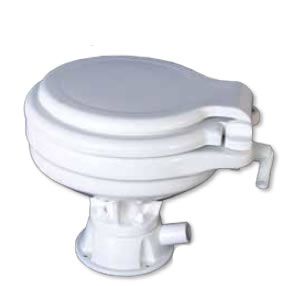
Blakes Lavac Popular Model
Using the same type of manual diaphragm pump commonly used to dry up bilges, the Blakes Lavac does not require electricity or pressurized water. An electric version, however, is an option.
The small white vitreous porcelain bowl is a mere 12 inches high and would typically be mounted on a small riser for added comfort. The base can be easily disassembled and turned to allow the discharge hose to be directed left, right, or back.
The white plastic seat and cover each have special round gaskets. The toilet seat must be closed, and these seals must seal properly when pumping to create the vacuum for flushing and to allow the pump to pull clean water in.
The separate white plastic diaphragm manual pump is 5¼ inches high and 7 inches wide with four flanges for securing to the bulkhead. It comes with a 12-inch stainless-steel removable pump handle that travels about 6 inches with each pump stroke. The top or front of the pump has a wide opening with a screw-on lid to access the rubberized bellows of the pump for cleaning.
For toilet installation, the pump should be installed and secured to a firm bulkhead above the level of the pedestal base at a minimum. This allows some clean water to remain in the bowl after each flush and allows water to drain out of the pump bellows. If installed level with or below the pedestal base, water in the bowl would instead drain out through the pump or collect in the pump instead.
To prevent back-siphoning, the installer must loop the ¾-inch inlet hose above the waterline at maximum heel. In addition, the installer must drill a small hole at the top of the loop and install one of two airbleed plugs that are included with the toilet. These air-bleed plugs release the vacuum after each flush and determine how much water is left in the bowl after each flush.
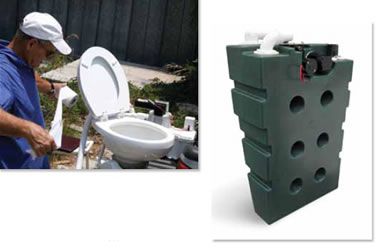
386
In addition to preventing back siphoning, this bleed hole relieves the pressure in the line so that the lid may be opened again after flushing. It also determines how much water will be drawn into the bowl for refilling after pumping has stopped. Normal operation leaves about a pint of water in the bowl, depending on the length of the intake hose and which air bleed plug is used. The bleed holes are tiny, so it’s important to keep these clear of any debris.
To flush the toilet, you must close the seat and lid and give eight to 10 steady full strokes of the pump handle; pause for 5 seconds and repeat. More strokes may be necessary, depending on the length of the hose runs. Once a few installation issues were resolved (described below), our test toilet performed very well. It evacuated our bananas and toilet paper with an average of 16 to 18 strokes and about 4 to 5 pints of water. Lavac’s tests show 3 to 4 pints.
Diaphragm pumps of this type are famously resistant to clogs. The valves and diaphragm last two to three years, but are cheap and easy to replace.
Like a few of the toilets in our other test, the Lavac makes the seemingly simple task of fastening a toilet seat to a toilet amazingly complicated. Six different pieces had to come together correctly before tightening the wing nuts to hold the lid down. Two of those pieces, a gasket and a wing nut, gave testers trouble and had to be replaced.
Since the vacuum principle of this toilet depends on the seat and cover sealing properly to the bowl, the hardware joining these pieces is critical. In any case, new gaskets and metal (metric) wing nuts from a local hardware store easily solved the problem.
During our first tries to fill the bowl, the seal around the seat and cover did not seem to hold a vacuum for more than 10 to 15 seconds. Testers could hear air sucking in after pumping. We replaced the seat and cover gaskets with new ones, and that immediately solved the problem. We recommend keeping a spare set if you plan to venture farther afield.
In our conversations with Lavac after testing, we learned that this gasket and hinge assembly has been improved, ensuring a tight seal out of the box.
Bottom line: This Lavac system is highly regarded by many cruising sailors for its simplicity and the robust construction. The diaphragm pump is difficult to clog, and if it does, it is fairly easy to clear. Flushing is efficient, requiring about 2 to 4 pints of water per flush.
Conclusion
Switching to a vacuum system requires some changes in habit. With the VacuFlush system, it is important to turn off the power to the system at a proper switch or breaker whenever leaving the boat for long periods. If any of the seals in the toilet or hoses should begin to leak, the vacuum pressure would drop and the vacuum generator would turn on automatically, gradually running down the ship’s house batteries.
Users also will have to be more vigilant about what goes into the toilet. Reduced water usage means that the bowl is not rinsed as well. Some VacuFlush owners provide a separate small garbage bin for users to deposit toilet paper in.
Holding the vacuum pressure is critical. Any leak around any hose fitting would compromise the performance of the system. The installation guides suggest having a digital vacuum gauge (available from Sealand) to assure vacuum level integrity, and this would be a good addition on any boat planning a cruise of a year or more.
Although the vacuum-pressure reduces water usage, some of the best electric-flush toilets in our tests earlier this year (see March 2011) were also quite miserly with water, and more forgiving with solids. If you host many guests who are unschooled in the ways of the marine toilet, you should also look at other models from Dometic and other manufacturers that had vortex-type water pumps to break up and wash out solid waste. If you like the VacuFlush concept, consider having a pro install it, and explain how to operate, maintain, and troubleshoot the system.
The Blakes Lavac is best compared to compact manual toilets like the Raritan PHII or the Jabsco Compact (see January 2008). It is aimed at the basic, “keep it simple” sailor. It is relatively inexpensive, small, lightweight, easy to install, use, and maintain. It has very few moving parts and is definitely our Budget Buy choice in this comparison.
We recommend the VacuFlush system for the sailor who wants to be extra-stingy with water and wants the conveniences of a vacuum-type system. For new-boat buyers and builders, the more simple SailVac system or a similar unit with a matching holding tank and vacuum generator would be our choice. The VacuFlush with a separate vacuum generator is better suited for integrating into an existing holding tank system.

































